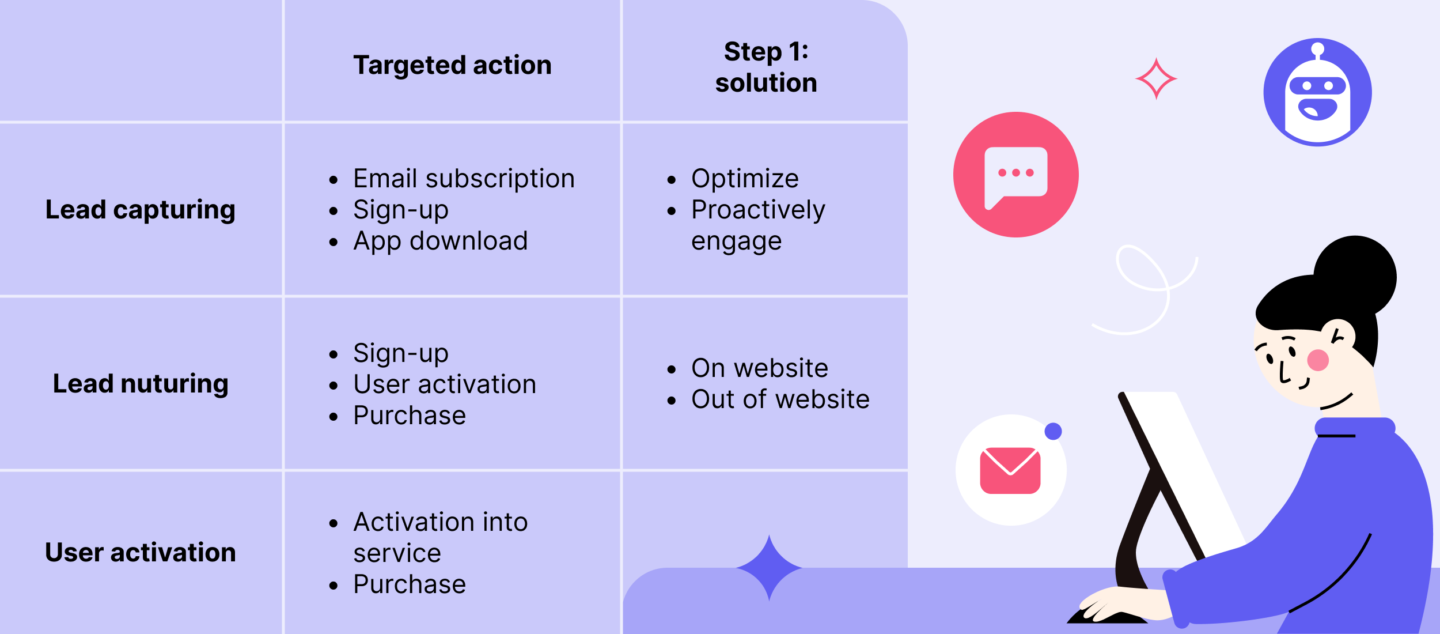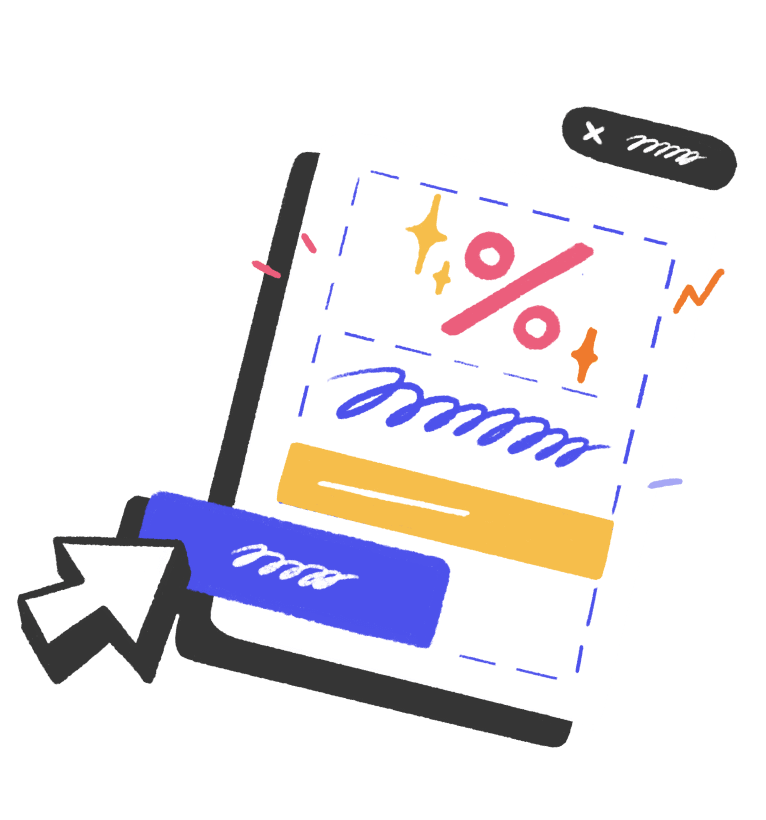Download a free growth marketing strategy template to plan your business success

Developing a strategy for growth is like planting a garden — it takes time, effort, and care, but the results are worth it 🌸
Growth marketing strategy is a comprehensive plan that outlines how you will acquire new customers, retain existing ones, and increase your revenue and profitability. There are numerous tactics businesses use to engage website visitors and customers at different stages of their journey. Dashly expert team tested the best of them. To help you, we collected the most popular of them into an easy-to-use constructor.
The customer engagement strategy guide template includes everything you need to create multi-steps campaign
- Choose the step of the strategy you want to improve;
- Pick a solution (but we recommend combining tactics);
- Decide what value to offer: lead magnet, discount, free trial, etc.;
- Choose one of solutions for step 2 (engagement out of your website): email, SMS, push notification, etc.;
- Think over CTA that reflects your goal. There is a list of examples.
Here are a few scenarios you can build with Dashly template:
Improve lead generation on your website
Use a growth marketing plan to build a growth strategy for lead capturing. Choose target action, strategy to your goal, product to highlight in the offer, tools, and write marketing copy. There are relevant examples to guide you inside.
Here is what it looks like:

Get access to this and four other strategies in the template below 👇
Thanks! Here’s your copy of the growth strategy template

Nurture leads
This growth marketing plan template includes a combination of tools and values to nurture leads on different channels as well. Here is a first step options to guide you 👇
Lead nurturing examples we provided in the marketing plan

Find more ideas in the template below
Use it to build a customer engagement strategy that meets your company goals and budget. It includes examples of the marketing goals, tools, and marketing copy you can use or add yours! Grab the growth marketing plan template below and get access to it instantly 👇
Thanks! Here’s your copy of the growth strategy template

Growth strategies to plan user activation
In this strategic document you’ll discover a step-by-step plan on user activation with variables of CTAs, tools to use, value to offer.
Build your use activation plan in a matter of minutes to achieve effective growth.
Here is how it looks like:

The examples include marketing tools, CTAs, product offers to provide as a value in your marketing copy.
Create strategy to improve retention
Use templates we provided to build your ideal strategy for a client retention rate effective growth. There are examples like in-time support, checking clients progress, celebrate milestones and user achievements, etc.
Here is how it looks like:

Growth strategy to skyrocket reactivation
Client reactivation is based on the personalized approach and automation. Exactly these two concepts we used to build this marketing plan for an effective growth of your business. Here are some examples: engage them with personalized discount via email, invite for an event as a VIP client, provide a free consultation, etc.
Here is how it looks like:

Experiment with provided marketing variables to achieve brand or product growth faster. Each of these ideas we tested with Dashly clients in SaaS, eCommerce, and EdTech industries.
How to use a growth marketing plan
- Open the template and go to the File section to make its copy.
- Define the funnel step to work with.
- Follow the step (horizontal) and choose one of options or add yours.
- Create a new row below the chosen scenario to copy your choice there.
- Your strategy structure is ready 🎉
FAQ on growth marketing plan
How do you write a marketing growth strategy?
Writing growth marketing strategy starts with analyzing your marketing funnel to find out its weak place. If it is, for example, lead conversion into sign-up, your next step will be defining the goal. Here is how it can sound — achieve 200 sign-ups in 3 weeks. Third step is choosing a method, it can be an extended product trial pop-up on the website.
Find marketing CTA examples to use for these offer in our growth marketing plan.
What are the four major growth strategies?
1. Market Penetration: This strategy focuses on selling more of your existing products or services to your existing market segments. The objective here is to attain dominance in your current market through methods like competitive pricing, marketing promotions, and improving product quality.
2. Market Development: This strategy involves selling your existing products or services into new geographical areas or new customer segments. It requires comprehensive market research to understand new customers’ needs and a well-planned marketing strategy to drive growth in these new markets.
3. Product Development: A product development growth strategy involves creating new products or services for your existing markets. This growth strategy requires understanding your customers’ needs, investing in research and development, and using marketing strategies to create awareness for these new products or services.
4. Diversification: Diversification is a growth strategy that entails a company either creating or acquiring new products or services and marketing them to new customer segments. This is typically the riskiest growth strategy as it requires venturing into unfamiliar territory where both the product and market may be relatively unknown to the business.
How do you structure a growth strategy?
Firstly, you must have an intimate understanding of your product — know the problem it solves. Your product is the centerpiece of your growth strategy.
Next, define clear objectives. Determine if your focus is on user acquisition, retention, or brand awareness. Having clear goals guides your growth marketing efforts effectively.
Familiarize yourself with your target audience. In-depth knowledge about their demographics, needs, and habits helps shape your marketing strategies.
Now, design and implement a variety of growth strategies. This can involve using several marketing channels such as SEO, content, and social media. Adjust your strategies based on observed performance and data gathered.
An ideal growth strategy is data-driven, versatile, and continuously developing in alignment with market dynamics and target audience behavior. Therefore, your strategy should always be under review to ensure effective growth marketing.
What is an example of a growth strategy?
Here’s an example of a growth strategy using chatbots for lead generation:
Objective: Increase lead generation by 20% in the next quarter.
Growth Marketing Plan Template:
👉 Product Knowledge: Understand what your product offers and how it stands out from competitors. Personalize the chatbot responses to highlight these features and benefits to potential leads.
👉 Audience Definition: Recognize who your ideal customers are, what their needs might be, and how your product can provide a solution. Configure your chatbot to identify and qualify these leads based on this information.
👉 Chatbot Design and Implementation: Incorporate a user-friendly chatbot on your website and social media platforms. It should engage visitors, address their queries, provide them with relevant product information, and eventually guide them into the sales funnel.
👉 Engagement Strategies: Implement growth marketing tactics to drive traffic to your website or social media profiles where your chatbot operates. These could include SEO strategies, content marketing, social media promotions, etc.
👉 Feedback and Optimization: Regularly review your chatbot’s interactions. Assess whether it’s effectively generating leads. Gather feedback from users and continuously refine its functionality and responses to improve engagement and lead generation.
In essence, this growth strategy leverages the power of chatbots to capture, qualify, and nurture potential leads, thereby enhancing your growth marketing efforts.
What is marketing growth funnel?
The marketing growth funnel, also known as the sales or conversion funnel, is a core concept in growth marketing that illustrates the journey of a customer from the awareness stage to the conversion stage. Here is an example of how it works:
👉 Awareness (Top of the Funnel): This is where potential customers first become aware of your brand or product. The strategy here is to attract the target audience through various marketing channels like social media advertising, FAQs, webinars, blog posts, and SEO.
👉 Interest (Middle of the Funnel): At this stage, potential customers have shown interest and are typically considering their options. The growth marketing strategy focuses on nurturing these leads by offering more specific, valuable content such as eBooks, newsletters, or other tailored resources.
👉 Evaluation (Middle of the Funnel): Here, prospective customers are evaluating your product against others. Strategic demos, case studies, testimonials and comparisons can be helpful to steer their decisions.
👉 Decision (Bottom of the Funnel): Potential customers are now ready to make a purchase decision. The strategy is to make the conversion process as simple as possible and provide compelling calls to action.
👉 Retention (Post-Purchase): After the purchase, customers may still need support and engagement. The strategy includes offering excellent customer service, requesting reviews, and promoting referral programs.
In this funnel structure, each stage requires distinct strategies for guiding potential customers towards growth and conversion.
What is the role of customer engagement in growth marketing?
Customer engagement is crucial in growth marketing. It’s the continuous interaction between a customer and a product company beyond just purchasing the product. High-level customer engagement leads to higher customer satisfaction, which drives customer retention and loyalty, ultimately leading to business growth.
What marketing strategies can be used to boost brand customer engagement?
Various marketing strategies can be employed to improve product client engagement. These can range from personalized email marketing, social media campaigns, content marketing to using push notifications. Companies often use a blend of these for effective customer engagement in growth marketing efforts.
What are brand growth marketers growth goals?
Brand growth marketing managers typically have several key growth goals that guide their product marketing strategies. Here are a few:
1. Increase Brand Awareness: A primary goal for growth marketers is to expand their brand’s visibility and recognition in the market. This typically involves promoting the brand through various marketing channels like social media, content marketing, PR outreach, and advertising.
2. Build an Engaged Customer Base: Growth marketers aim to not only attract but also engage their customer base. This involves creating valuable content, fostering community through social media, and ensuring regular and meaningful interactions with the brand.
3. Improve Customer Acquisition and Retention Rates: Converting prospects into customers and retaining them for the long term are vital goals for growth marketers. They often implement numerous strategies such as personalized marketing, great customer support, and loyalty programs to achieve this.


![The ultimate guide to growth marketing in 2025 [explained by a growth hacker]](https://www.dashly.io/blog/wp-content/uploads/2023/04/The-ultimate-guide-to-growth-marketing-explained-by-a-growth-hacker-720x317.png)


